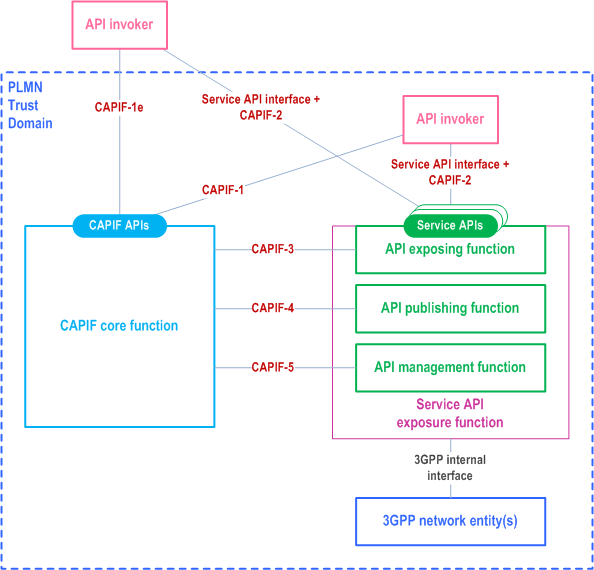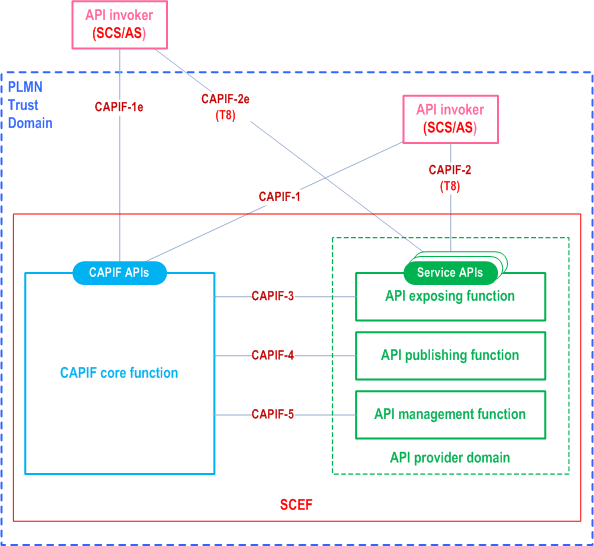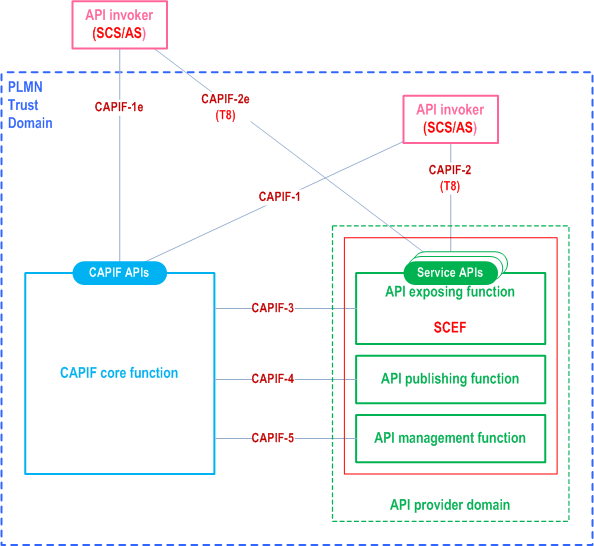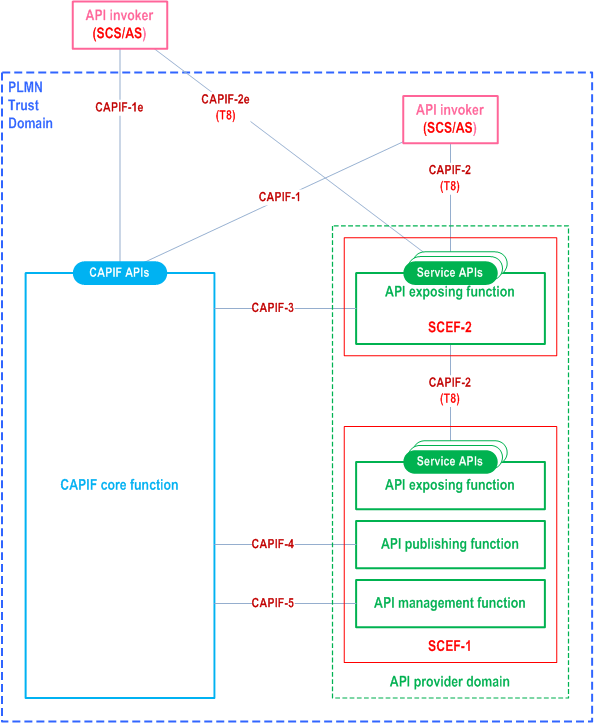Content for TS 23.222 Word version: 19.1.0
0…
4…
5…
6…
6.3…
6.4…
7…
8…
8.5…
8.8…
8.9…
8.13…
8.17…
8.21…
8.25…
8.26…
8.28…
8.30…
9…
10…
10.4…
10.7…
11…
A
B…
B.2…
B.3…
C…
D…
B CAPIF relationship with network exposure aspects of 3GPP systems
B.0 CAPIF utilization by service API provider
B.1 CAPIF relationship with 3GPP EPS network exposure
B.1.1 General
B.1.2 Deployment models
B.1.2.1 General
B.1.2.2 SCEF implements the CAPIF architecture
B.1.2.3 SCEF implements the service specific aspect compliant with the CAPIF architecture
B.1.2.4 Distributed deployment of the SCEF compliant with the CAPIF architecture
...
...
B CAPIF relationship with network exposure aspects of 3GPP systems p. 118
This Annex provides the relationship of CAPIF with network exposure aspects of 3GPP systems. Any system exposing capabilities as service APIs can implement CAPIF. Generic model for CAPIF utilization by service API provider is included. Network exposure aspects of EPS and 5GS are considered for illustration.
B.0 CAPIF utilization by service API provider p. 118
Figure B.0-1 illustrates the service API interaction with the CAPIF for utilizing framework aspects provided by the CAPIF.

The service API aspects of the 3GPP network services and capabilities such as subscriber management, mobility management, transport and other communication services can be exposed for consumption by external 3rd party applications (e.g. API invoker).
Framework aspects typically horizontal in nature caters to common functionality such as onboarding, offboarding, publishing, unpublishing, update service API, discovery, authentication, registration, authorization, logging, charging, monitoring, configuration, topology hiding, that are required to provide service APIs to API invokers. Service APIs can utilize the functions of the API provider domain (i.e. API exposing function, API publishing function, API management function) and interfaces CAPIF-3, CAPIF-4 and CAPIF-5 as specified in this specification.
The service API exposure function is connected to 3GPP network entity(s) via 3GPP internal interface(s). The API publishing function provides the service API information for publishing to the CAPIF core function.
For consuming service API, the API invoker interacts with the service API exposure function via service API interface and CAPIF-2/2e. While the service API interface is responsible for providing service aspects, CAPIF-2/2e supports service API by providing framework aspects such as authentication of the API invoker, authorization verification for the API invoker upon accessing the service API.
B.1 CAPIF relationship with 3GPP EPS network exposure p. 119
B.1.1 General p. 119
The Table B.1.1-1 shows the relationship between CAPIF and EPS network exposure aspects. The details of SCEF and its role in exposing network capabilities of EPS to 3rd party applications are specified in TS 23.682
| Aspects | CAPIF | EPS network exposure |
|---|---|---|
| Entity providing the APIs to external or 3rd party applications | AEF | SCEF |
| Entity providing framework related services to the applications (discovery, authentication, authorization, etc) | CAPIF core function | SCEF |
| Entity representing the external or 3rd party applications | API invoker | SCS/AS |
| Entity providing framework related services to support the APIs operation and management (publish, policy enforcements, charging) | CAPIF core function | SCEF |
| Interface/Reference point for exposing network capabilities as APIs | CAPIF-2 and CAPIF-2e (Do not include the service specific aspects) | T8 |
| Interface/Reference point for exposing framework services as APIs to the applications | CAPIF-1 and CAPIF-1e | Not specified. (May be via T8) |
| Interface/Reference point for framework services to support the APIs operation and management | CAPIF-3, CAPIF-4 and CAPIF-5 | Internal to SCEF |
B.1.2 Deployment models p. 119
B.1.2.1 General p. 119
Based on the relationship captured in Table B.1.1-1, the following deployment models for CAPIF are possible to enable EPS network exposure.
B.1.2.2 SCEF implements the CAPIF architecture p. 119
Figure B.1.2.2-1 illustrates the deployment model where SCEF implements the CAPIF architecture.

The SCEF can implement the functionalities of the CAPIF core function, the API exposing function, the API publishing function and the API management function.
According to the CAPIF architecture, CAPIF-2 and CAPIF-2e consist of framework aspects and service specific aspects. The service specific aspects are out of scope of CAPIF. T8 can implement the service specific aspects of CAPIF-2 and CAPIF-2e, and can provide the service APIs exposed by SCEF (AEF) to the SCS/AS (API invoker).
The SCEF can additionally provide CAPIF-1 and CAPIF-1e (CAPIF APIs) to the SCS/AS (API invokers).
B.1.2.3 SCEF implements the service specific aspect compliant with the CAPIF architecture p. 120
Figure B.1.2.3-1 illustrates the deployment model where SCEF implements the service specific aspect compliant with the CAPIF architecture.

3GPP EPS can deploy the CAPIF core function along with the SCEF.
The SCEF can implement the functionalities of the API provider domain functions.
According to the CAPIF architecture, CAPIF-2 and CAPIF-2e consist of framework aspects and service specific aspects. The service specific aspects are out of scope of CAPIF. T8 can implement the service specific aspects of CAPIF-2 and CAPIF-2e, and can provide the service APIs exposed by SCEF (AEF) to the SCS/AS (API invoker).
The SCEF can implement the CAPIF-3 reference point/interface to the CAPIF core function.
B.1.2.4 Distributed deployment of the SCEF compliant with the CAPIF architecture p. 121
Figure B.1.2.4-1 illustrates the distributed deployment model where the SCEF implements the service specific aspect compliant with the CAPIF architecture.

The 3GPP EPS can deploy the CAPIF core function, the SCEF-2 (API exposing function as a gateway) along with the SCEF-1 as illustrated in subclause 7.3.
The SCEF can implement the functionalities of API provider domain functions.
According to the CAPIF architecture, CAPIF-2 or CAPIF-2e consists of framework aspects and service specific aspects. The service specific aspects are out of scope of the CAPIF. T8 can implement the service specific aspects of CAPIF-2 or CAPIF-2e and can provide the service APIs exposed by the SCEF-2 (AEF as a gateway) to the SCS/AS (API invoker).
The SCEF-2 can implement the CAPIF-3 reference point to the CAPIF core function and the SCEF-1 can implement the CAPIF-4 and CAPIF-5 reference points to the CAPIF core function.